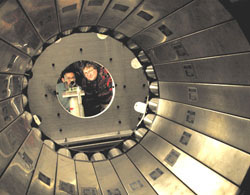Gazing into a Nuclear Mirror

Protons and neutrons are essentially the same, in theory–that is, if you ignore the proton’s charge. In the 29 April print issue of PRL, a team reports the most precise tests yet of the similarity in the behavior of neutrons and protons in a nucleus. The experiments involved a pair of so-called mirror nuclei, where the number of neutrons in one nucleus matches the number of protons in the other. Although the results didn’t upset conventional theory, the experiments are the first to use stable beams of nuclei with such a wide disparity between the two nucleon types–the so-called proton-rich nuclei. Using the same techniques, researchers hope to study heavier and more exotic nuclei to further probe the structure of the nucleus.
Mirror pairs have opposite numbers of protons and neutrons. For example, argon-32 has 18 protons and 14 neutrons, while silicon-32 contains the reverse, 14 protons and 18 neutrons. If it weren’t for the protons’ charge–which has a small effect compared with the strong nuclear force–these nuclei would be identical. Nuclear physicists have looked at mirror pairs where the difference between proton and neutron numbers was only one or two, but the strongest tests for neutron-proton symmetry come from so-called distant mirror nuclei, where the difference is larger. The latest set of experiments analyzed the argon-silicon pair, and they required new technology.
The collaboration of researchers from Florida State University in Tallahassee and Michigan State University (MSU) in East Lansing worked at the National Superconducting Cyclotron Laboratory at MSU. To make a beam of unstable argon-32 nuclei, they sent a stable argon-36 beam into a beryllium target and magnetically collected the correct isotope from the resulting debris. “A bit like tossing a bunch of dishes in the air and then picking out pieces of the right size,” explains team member Thomas Glasmacher of MSU. The team smashed the argon-32 into a gold target, which kicked some of the nuclei from their ground state to their lowest excited state. The researchers compared the likelihood, or “strength,” of the transition in argon-32 to that of a similar transition in silicon-32. Subtracting the effects of charge, the results were identical, even at this new level of precision.
The studies seem to validate accepted theories of nuclear structure. Given the power of the new techniques, “one would have hoped for dramatic results–such as the breakdown of [proton-neutron] symmetry,” observes Kim Lister of Argonne National Laboratory. “These exotic nuclei,” he sighs, “are disappointingly well behaved.” The new technology seems not to be disappointing, however. Turning beams of radioactive nuclei into smart nuclear probes is “a singular achievement,” says Peter Parker of Yale University. “A distinct step forward in better understanding the structure of nuclei.”
–Sharmila Kamat
Sharmila Kamat is a freelance science writer in Cleveland, OH.


